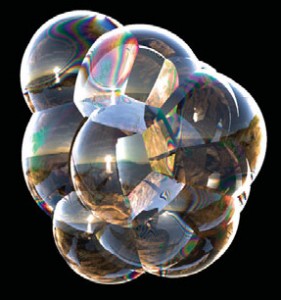David Bruggeman (Pasco Phronesis blog) has written up, as he so often does, a fascinating art/science piece in his May 28, 2015 post (Note: A link has been removed),
Opening next month [June 2015] at the Dilston Grove Gallery at GDP London is Music of the Spheres, an exhibition that uses bioinformatics to record music. Dr. Nick Goldman of the European Bioinformatics Institute has been working on new technologies for encoding large amounts of information into DNA. Collaborating with Charlotte Jarvis, the two have worked on installations of bubbles that would contain DNA encoded with music (the DNA is suspended in soap solution).
There’s more information about the exhibit on the Music of the Spheres webpage on the CGP London website,
Music of the Spheres utilises new bioinformatics technology developed by Dr. Nick Goldman to encode a new musical recording by the Kreutzer Quartet into DNA.
The DNA has been suspended in soap solution and will be used by visual artist Charlotte Jarvis to create performances and installations filled with bubbles. The recording will fill the air, pop on visitors skin and literally bathe the audience in music.
Dr. Nick Goldman and Charlotte Jarvis have been working together for the past year to create a series of moving visual and musical experiences that explore the scope and future ubiquity of DNA technologies.
The Kreutzer Quartet’s new composition for string quartet loosely follows the traditional form of a concerto, in comprising of three musical movements. The second movement only exists in the form of a recording encoded into DNA.
For the exhibition the DNA will be suspended in soap solution and used to create silent installations filled with bubbles. The bubbles will be accompanied by a video projection showing the musicians playing in the server room of the European Bioinformatics Institute, Cambridge.
In response to the growing challenge of storing vast quantities of biological data generated by biomedical research Dr. Nick Goldman and the European Bioinformatics Institute have developed a method to encode huge amounts of information in DNA itself. Every day the huge quantities and speed of data pouring into servers gets larger. When research groups sequence DNA the file sizes are too large to be kept on local computers. It is this problem that was the motivation for Nick Goldman to develop his new technology. Their goal is a system that will safely store the equivalent of one million CDs in a gram of DNA for 10,000 years. Nick’s work was has been featured in The New York Times, The Guardian and on BBC News amongst other media outlets.
The Kreutzer Quartet will play the full-length composition live during the preview on 12 June [2015] timed with the setting of the sun through the large westerly windows. [emphasis mine] During the passage of the second movement the stage will fall silent, the music will be released into the auditorium in the form of bubbles. The performance will be accompanied by film projection and a discussion about the project.
The exhibit runs from June 12 – July 5, 2015. Hours and location can be found on the CGP website.
The Music of the Spheres DNA/music project was first mentioned here in a May 5, 2014 post about the launch of the book ‘Synthetic Aesthetics: Investigating Synthetic Biology’s Designs on Nature’. The launch featured a number of performances and events, scroll down abut 80% of the way for the then description of Music of the Spheres.
